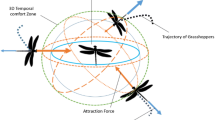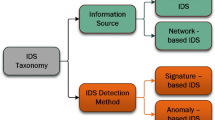Abstract
Intrusion detection is one of the most crucial activities for security infrastructures in network environments, and it is widely used to detect, identify and track malicious threats. A common approach in intrusion detection systems (IDSs) specifically in anomaly detection is evolutionary algorithm that works as intrusion detector. Still, it has been challenging to design a precise and reliable IDS to determine security threats due to the large capacity of network data which contains redundant and irrelevant features. It does not only decrease the process of classification but also prevents a classifier from making precise decisions. To increase the accuracy and reduce the false alarm rate, in this study integration of ensemble feature selection (EFS) and grasshopper optimization algorithm (GOA), called EFSGOA is developed. Firstly, EFS method is applied to rank the features for selecting the top subset of relevant features. Afterward, GOA is utilized to identify significant features from the obtained reduced features set produced by EFS technique that can contribute to determine the type of attack. Furthermore, GOA utilizes support vector machine (SVM) as a fitness function to obtain the noteworthy features and to optimize penalty factor, kernel parameter, and tube size parameters of SVM for maximizing the classification performance. The experimental results demonstrate that EFSGOA method has performed better and obtained high detection rate of 99.69%, accuracy of 99.98% and low false alarm rate of 0.07 in NSL-KDD and high detection rate of 99.26%, accuracy of 99.89% and low false alarm rate of 0.097 in KDD Cup 99 data. Moreover, the proposed method has succeeded in achieving higher performance compared to other state-of-art techniques in terms of accuracy, detection rate, false alarm rate, and CPU time.






Similar content being viewed by others
References
Bouyeddou, B., Harrou, F., Kadri, B., Sun, Y.: Detecting network cyber-attacks using an integrated statistical approach. Clust. Comput. (2020). https://doi.org/10.1007/s10586-020-03203-1
Ring, M., Wunderlich, S., Scheuring, D., Landes, D., Hotho, A.: A survey of network-based intrusion detection data sets. Comput. Security (2019). https://doi.org/10.1016/j.cose.2019.06.005
Shukla, A.K.: An efficient hybrid evolutionary approach for identification of zero-day attacks on wired/wireless network system. Wirel. Pers. Commun. (2020). https://doi.org/10.1007/s11277-020-07808-y
Zakeri, A., Hokmabadi, A.: Efficient feature selection method using real-valued grasshopper optimization algorithm. Expert Syst. Appl. 119, 61–72 (2019)
Jin, D., Lu, Y., Qin, J., Cheng, Z., Mao, Z.: Swiftids: real-time intrusion detection system based on lightGBM and parallel intrusion detection mechanism. Comput. Security 97, 101984 (2020)
Dwivedi, S., Vardhan, M., Tripathi, S.: Distributed denial-of-service prediction on iot framework by learning techniques. Open Comput. Sci. 10, 220–230 (2020)
Mohammadi, S., Mirvaziri, H., Ghazizadeh-Ahsaee, M., Karimipour, H.: Cyber intrusion detection by combined feature selection algorithm. J. Inf. Security Appl. 44, 80–88 (2019)
Mafarja, M., Aljarah, I., Faris, H., Hammouri, A.I., Ala’M, A.-Z., Mirjalili, S.: Binary grasshopper optimisation algorithm approaches for feature selection problems. Expert Syst. Appl. 117, 267–286 (2019)
Shukla, A.K., Pippal, S.K., Chauhan, S.S.: An empirical evaluation of teaching-learning-based optimization, genetic algorithm and particle swarm optimization. Int. J. Comput. Appl. (2019). https://doi.org/10.1080/1206212X.2019.1686562
Saremi, S., Mirjalili, S., Lewis, A.: Grasshopper optimisation algorithm: theory and application. Adv. Eng. Softw. 105, 30–47 (2017)
Ibrahim, H.T., Mazher, W.J., Ucan, O.N., Bayat, O.: A grasshopper optimizer approach for feature selection and optimizing SVM parameters utilizing real biomedical data sets. Neural Comput. Appl. 31, 5965–5974 (2019)
Mirjalili, S.Z., Mirjalili, S., Saremi, S., Faris, H., Aljarah, I.: Grasshopper optimization algorithm for multi-objective optimization problems. Appl. Intell. 48, 805–820 (2018)
Singh, I., Kumar, N., Srinivasa, K., Sharma, T., Kumar, V., Singhal, S.: Database intrusion detection using role and user behavior based risk assessment. J. Inf. Security Appl. 55, 102654 (2020)
Dwivedi, S., Vardhan, M., Tripathi, S.: Incorporating evolutionary computation for securing wireless network against cyberthreats. J. Supercomput. 76, 8691–8728 (2020)
Tidjon, L.N., Frappier, M., Mammar, A.: Intrusion detection systems: a cross-domain overview. IEEE Commun. Surv. Tutor. 21(4), 3639–3681 (2019)
Chen, J., Qi, X., Chen, L., Chen, F., Cheng, G.: Quantum-inspired ant lion optimized hybrid k-means for cluster analysis and intrusion detection. Knowl. Based Syst. 203, 106167 (2020)
Qadri, Y.A., Ali, R., Musaddiq, A., Al-Turjman, F., Kim, D.W., Kim, S.W.: The limitations in the state-of-the-art counter-measures against the security threats in H-IoT. Clust. Comput. 23, 2047–2065 (2020)
Shukla, A.K.: Detection of anomaly intrusion utilizing self-adaptive grasshopper optimization algorithm. Neural Comput. Appl. (2020). https://doi.org/10.1007/s00521-020-05500-7
Wang, Y., Meng, W., Li, W., Li, J., Liu, W.-X., Xiang, Y.: A fog-based privacy-preserving approach for distributed signature-based intrusion detection. J. Parallel Distrib. Comput. 122, 26–35 (2018)
Salo, F., Nassif, A.B., Essex, A.: Dimensionality reduction with IG-PCA and ensemble classifier for network intrusion detection. Comput. Netw. 148, 164–175 (2019)
Sadiq, A.S., Alkazemi, B., Mirjalili, S., Ahmed, N., Khan, S., Ali, I., Pathan, A.-S.K., Ghafoor, K.Z.: An efficient IDS using hybrid magnetic swarm optimization in WANETs. IEEE Access 6, 29041–29053 (2018)
Luo, J., Chen, H., Xu, Y., Huang, H., Zhao, X., et al.: An improved grasshopper optimization algorithm with application to financial stress prediction. Appl. Math. Model. 64, 654–668 (2018)
Bhuvaneswari, G., Manikandan, G.: An intelligent intrusion detection system for secure wireless communication using IPSO and negative selection classifier. Clust. Comput. 22, 12429–12441 (2019)
Manimurugan, S., Majdi, A.-Q., Mohmmed, M., Narmatha, C., Varatharajan, R.: Intrusion detection in networks using crow search optimization algorithm with adaptive neuro-fuzzy inference system. Microprocessors Microsyst. 79, 103261 (2020)
Xie, M., Hu, J.: Evaluating host-based anomaly detection systems: a preliminary analysis of ADFA-LD. In: 6th International Congress on Image and Signal Processing (CISP), vol. 3, pp. 1711–1716. IEEE (2013)
Abdulhammed, R., Musafer, H., Alessa, A., Faezipour, M., Abuzneid, A.A.: Machine learning approaches for flow-based intrusion detection systems (2018)
Moustafa, N., Slay, J.: The evaluation of network anomaly detection systems: statistical analysis of the UNSW-NB15 data set and the comparison with the KDD99 data set. Inf. Security J. Glob. Perspect. 25, 18–31 (2016)
Kaur, S., Singh, M.: Hybrid intrusion detection and signature generation using deep recurrent neural networks. Neural Comput. Appl. 32, 7859–7877 (2019)
Mazini, M., Shirazi, B., Mahdavi, I.: Anomaly network-based intrusion detection system using a reliable hybrid artificial bee colony and AdaBoost algorithms. J. King Saud Univ. Comput. Inf. Sci. 31(4), 541–553 (2018)
Sharma, R., Chaurasia, S.: An enhanced approach to fuzzy c-means clustering for anomaly detection. In: Proceedings of First International Conference on Smart System, Innovations and Computing, pp. 623–636. Springer, Singapore (2018)
Hezavehi, S.M., Rahmani, R.: An anomaly-based framework for mitigating effects of DDOS attacks using a third party auditor in cloud computing environments. Clust. Comput. 23(4), 1–19 (2020)
Kumar, V., Sinha, D., Das, A.K., Pandey, S.C., Goswami, R.T.: An integrated rule based intrusion detection system: analysis on UNSW-NB15 data set and the real time online dataset. Clust. Comput. 23, 1397–1418 (2020)
Jaber, A.N., Rehman, S.U.: FCM-SVM based intrusion detection system for cloud computing environment. Clust. Comput. 23, 3221–3231 (2020)
Shukla, A.K.: Building an effective approach toward intrusion detection using ensemble feature selection. Int. J. Inf. Security Privacy (IJISP) 13, 31–47 (2019)
Kuang, F., Xu, W., Zhang, S.: A novel hybrid KPCA and SVM with GA model for intrusion detection. Appl. Soft Comput. 18, 178–184 (2014)
Bolon-Canedo, V., Sanchez-Marono, N., Alonso-Betanzos, A.: Feature selection and classification in multiple class datasets: An application to KDD cup 99 dataset. Expert Syst. Appl. 38, 5947–5957 (2011)
Haider, W., Hu, J., Slay, J., Turnbull, B.P., Xie, Y.: Generating realistic intrusion detection system dataset based on fuzzy qualitative modeling. J. Netw. Comput. Appl. 87, 185–192 (2017)
Wang, H., Gu, J., Wang, S.: An effective intrusion detection framework based on SVM with feature augmentation. Knowl. Based Syst. 136, 130–139 (2017)
Ebrahimpour, M.K., Eftekhari, M.: Ensemble of feature selection methods: a hesitant fuzzy sets approach. Appl. Soft Comput. 50, 300–312 (2017)
Rankawat, S.A., Dubey, R.: Robust heart rate estimation from multimodal physiological signals using beat signal quality index based majority voting fusion method. Biomed. Signal Process. Control 33, 201–212 (2017)
Fathy, A.: Recent meta-heuristic grasshopper optimization algorithm for optimal reconfiguration of partially shaded pv array. Sol. Energy 171, 638–651 (2018)
Ewees, A.A., Elaziz, M.A., Houssein, E.H.: Improved grasshopper optimization algorithm using opposition-based learning. Expert Syst. Appl. 112, 156–172 (2018)
Mafarja, M., Aljarah, I., Heidari, A.A., Faris, H., Fournier-Viger, P., Li, X., Mirjalili, S.: Binary dragonfly optimization for feature selection using time-varying transfer functions. Knowl. Based Syst. 161, 185–204 (2018)
Lee, C.-P., Leu, Y., Yang, W.-N.: Constructing gene regulatory networks from microarray data using GA/PSO with DTW. Appl. Soft Comput. 12, 1115–1124 (2012)
Cortes, C., Vapnik, V.: Support-vector networks. Mach. Learn. 20, 273–297 (1995)
Aladeemy, M., Tutun, S., Khasawneh, M.T.: A new hybrid approach for feature selection and support vector machine model selection based on self-adaptive cohort intelligence. Expert Syst. Appl. 88, 118–131 (2017)
Aburomman, A.A., Reaz, M.B.I.: A survey of intrusion detection systems based on ensemble and hybrid classifiers. Comput. Security 65, 135–152 (2017)
Tavallaee, M., Bagheri, E., Lu, W., Ghorbani, A. A.: A detailed analysis of the KDD cup 99 data set. In: IEEE Symposium on Computational Intelligence for Security and Defense Applications, 2009 (CISDA 2009). IEEE, pp. 1–6 (2009)
Cunningham, R.K., Lippmann, R.P., Fried, D.J., Garfinkel, S.L., Graf, I., Kendall, K.R., Webster, S.E., Wyschogrod, D., Zissman, M.A.: Evaluating intrusion detection systems without attacking your friends: the 1998 DARPA intrusion detection evaluation. Technical Report, Massachusetts Institute of Tech Lexington Lincoln Lab (1999)
Buczak, A.L., Guven, E.: A survey of data mining and machine learning methods for cyber security intrusion detection. IEEE Commun. Surv. Tutor. 18, 1153–1176 (2016)
Ravale, U., Marathe, N., Padiya, P.: Feature selection based hybrid anomaly intrusion detection system using k means and RBF kernel function. Procedia Comput. Sci. 45, 428–435 (2015)
Nadiammai, G., Hemalatha, M.: Effective approach toward intrusion detection system using data mining techniques. Egyp. Inf. J. 15, 37–50 (2014)
Dwivedi, S., Vardhan, M., Tripathi, S., Shukla, A.K.: Implementation of adaptive scheme in evolutionary technique for anomaly-based intrusion detection. Evol. Intell. 13, 103–117 (2020)
Ambusaidi, M.A., He, X., Nanda, P.: Unsupervised feature selection method for intrusion detection system. In: Trustcom/BigDataSE/ISPA, vol. 1, pp. 295–301. IEEE (2015)
Gogoi, P., Bhuyan, M.H., Bhattacharyya, D., Kalita, J.K.: Packet and flow based network intrusion dataset. In: International Conference on Contemporary Computing, Springer, pp. 322–334 (2012)
Abd-Eldayem, M.M.: A proposed http service based IDs. Egyp. Inf. J. 15, 13–24 (2014)
Kim, G., Lee, S., Kim, S.: A novel hybrid intrusion detection method integrating anomaly detection with misuse detection. Expert Syst. Appl. 41, 1690–1700 (2014)
Author information
Authors and Affiliations
Corresponding author
Additional information
Publisher's Note
Springer Nature remains neutral with regard to jurisdictional claims in published maps and institutional affiliations.
Rights and permissions
About this article
Cite this article
Dwivedi, S., Vardhan, M. & Tripathi, S. Building an efficient intrusion detection system using grasshopper optimization algorithm for anomaly detection. Cluster Comput 24, 1881–1900 (2021). https://doi.org/10.1007/s10586-020-03229-5
Received:
Revised:
Accepted:
Published:
Issue Date:
DOI: https://doi.org/10.1007/s10586-020-03229-5




